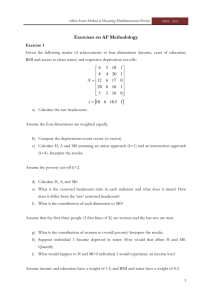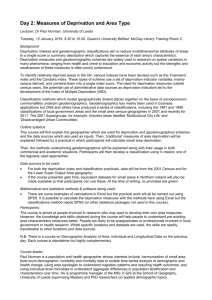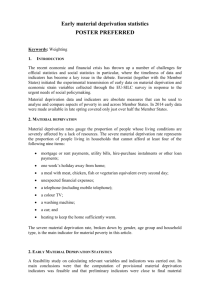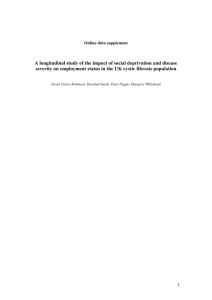What is the Northern Ireland Multiple Deprivation Measure (NIMDM)?
advertisement
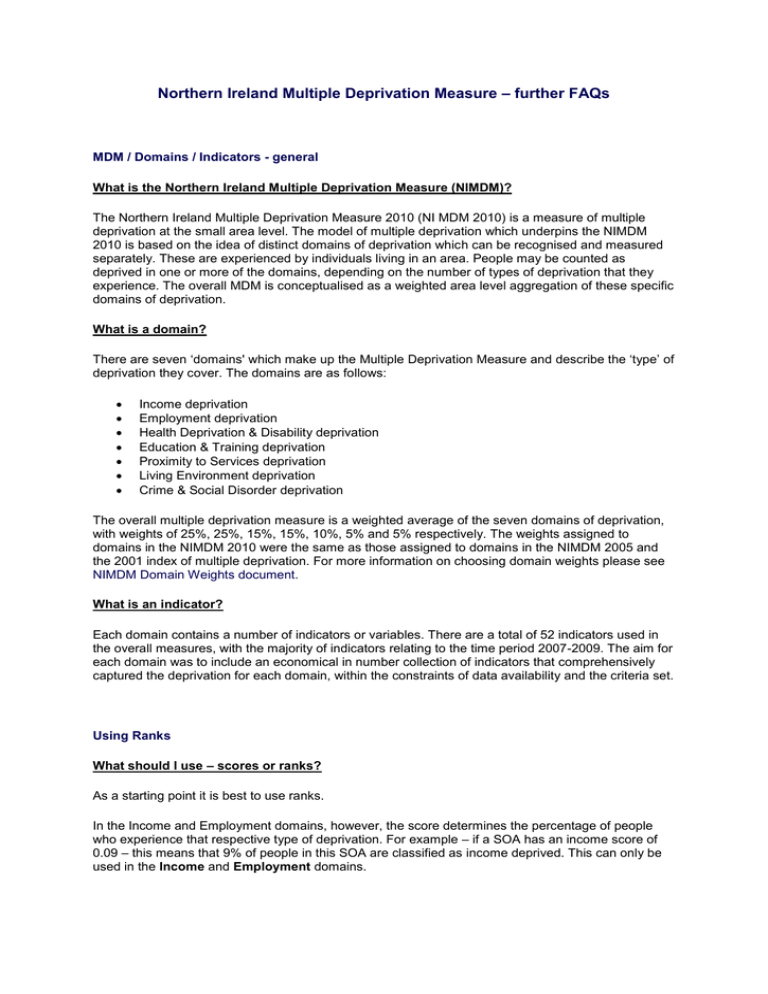
Northern Ireland Multiple Deprivation Measure – further FAQs MDM / Domains / Indicators - general What is the Northern Ireland Multiple Deprivation Measure (NIMDM)? The Northern Ireland Multiple Deprivation Measure 2010 (NI MDM 2010) is a measure of multiple deprivation at the small area level. The model of multiple deprivation which underpins the NIMDM 2010 is based on the idea of distinct domains of deprivation which can be recognised and measured separately. These are experienced by individuals living in an area. People may be counted as deprived in one or more of the domains, depending on the number of types of deprivation that they experience. The overall MDM is conceptualised as a weighted area level aggregation of these specific domains of deprivation. What is a domain? There are seven ‘domains' which make up the Multiple Deprivation Measure and describe the ‘type’ of deprivation they cover. The domains are as follows: Income deprivation Employment deprivation Health Deprivation & Disability deprivation Education & Training deprivation Proximity to Services deprivation Living Environment deprivation Crime & Social Disorder deprivation The overall multiple deprivation measure is a weighted average of the seven domains of deprivation, with weights of 25%, 25%, 15%, 15%, 10%, 5% and 5% respectively. The weights assigned to domains in the NIMDM 2010 were the same as those assigned to domains in the NIMDM 2005 and the 2001 index of multiple deprivation. For more information on choosing domain weights please see NIMDM Domain Weights document. What is an indicator? Each domain contains a number of indicators or variables. There are a total of 52 indicators used in the overall measures, with the majority of indicators relating to the time period 2007-2009. The aim for each domain was to include an economical in number collection of indicators that comprehensively captured the deprivation for each domain, within the constraints of data availability and the criteria set. Using Ranks What should I use – scores or ranks? As a starting point it is best to use ranks. In the Income and Employment domains, however, the score determines the percentage of people who experience that respective type of deprivation. For example – if a SOA has an income score of 0.09 – this means that 9% of people in this SOA are classified as income deprived. This can only be used in the Income and Employment domains. My SOA has a rank of 350 – what does this mean? Your SOA is the 350th most deprived SOA in Northern Ireland. The ranks are from 1 (most deprived) to 890 (least deprived). My SOA has a rank of 300 and my neighbouring SOA has a rank of 100 – what does this mean? From this information it can be said that the SOA with rank 100 is more deprived than the SOA ranked 300. It cannot be said how much more or less deprived each SOA is. For example, it cannot be said the one SOA is three times more or less deprived than the other. My SOA has a score of 0.5 – what does this mean? Is this score for the Income or Employment domain? If yes – if you multiply this score by 100 this gives you the percentage of people in your SOA who are classed as suffering from that type of deprivation. For all other scores, please see below: If no – the number itself is relatively meaningless. The score was derived from a statistical procedure in order to create ranks for this domain. The only way the score can be used is to understand the differences in magnitude between the ranks. My SOA has a rank of 890 - is it the most affluent SOA? Not necessarily - the NIMDM is a measure of deprivation and not affluence. Indicators were chosen that best measure different aspects of deprivation, not to measure the lack of affluence. Are there population denominators available for the NI MDM 2010 measures and the SOAs? Yes, small-area population estimates for Super Output Areas have been calculated for the time period 2001 - 2008. Information is available for Outputs and Super Output Area and can be found on NINIS under the Population theme. Will the indicator data be released? The Proximity to Services indicators have been released and can be found on NINIS under the Deprivation theme. Can the NI MDM measures be compared across the UK? It is not advised to compare the deprivation measures across the UK as data definitions, collection methods and base populations are not the same across Northern Ireland, England, Scotland and Wales. Also the UK regions have produced their measures in different years. For further details on this click here: Indices of Deprivation across the UK However if you have a specific policy use and would like to discuss, please get in touch with us via deprivation.nisra@dfpni.gov.uk Comparing 2010 and 2005 results Can the NI MDM 2010 and 2005 measures be used to assess whether deprivation has improved in my area? The NIMDM is a relative measure of deprivation. As such areas are ranked from most deprived to least deprived. Using only the ranks of the deprivation domains it is not possible to say if deprivation in an area has increased, decreased or remained the same. For example an area moving from rank 25 to rank 100 may have done so as deprivation in the area has lessened while all other areas have remained the same, may have the same level of deprivation in the area as in previous years while concentration of deprivation in other areas has increased, may have improved a little while other areas have improved but less, may have increased concentrations of deprivation while deprivation in other areas has increased more. The NIMDM 2005 contained 43 indicators while the NIMDM 2010 contains 52. Although both NIMDMs were intended to measure deprivation the NIMDM 2010 indicators have been chosen taking account of current data availability, so that deprivation is measured as best as possible. Why has the deprivation rank in my area changed so much? Where there are large changes in deprivation rank it may be due to changes in the level of deprivation in the area. Also it could be due to changes in the population in the area. Has a new development been built or houses demolished? Either of these could affect the deprivation rank. It is worth considering changes in deprivation ranks alongside changes in population. Report Where can I get a copy of the report? Hard copies are available on request via 028 90 348 111 or deprivation.nisra@dfpni.gov.uk Alternatively you can download the report from the NISRA website http://www.nisra.gov.uk/deprivation/nimdm_2010.htm
